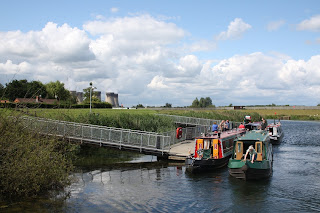North Yorkshire Waterways guide - available from http://www.richlow.co.uk/
The rivers Ouse, Ure, Foss and Derwent, and the Ripon and Pocklington canals.
There is a wide variety of navigable waterways in North Yorkshire, and the same can be said of the locations reached thereby. They are well worth cruising and visiting for their wealth of wildlife, countryside and history.
These waters are little cruised by visiting boats, but the attractions of York and Ripon should not be missed. Public transport is easily available for visits further afield.
Further downstream on the River Ouse are the River Derwent and the Pocklington Canal - both are waterways needing more visiting boats.
The following pictures were taken in 2011, on a group cruise, led by Richlow's narrowboat Madeley Wood. Richlow guides - Written by People Who Go There!
Selby Lock, with boats waiting to descend to the tidal River Ouse. The lock-keeper decides when locking takes place, depending on the time of the tides, and the destinations required - upstream on the Ouse to York, and the Ripon Canal - downstream to the River Derwent and the Pocklington Canal.

Exiting Selby Lock, and turning downstream towards the River Derwent.
At the confluence of the rivers Ouse and Derwent is Barmby Barrage, which controls the levels of fresh water in the Derwent, and prevents salination of those waters by the Ouse tides.
Approaching the Barrage lock, for access to the River Derwent.

On the River Derwent, the Barmby Barrage pontoon moorings.
If you hear that the River Derwent has an over-hanging trees problem, then rest assured. The trees were cut back in 2011.
River Derwent - Sutton Lock.
River Derwent. Head of navigation at Stamford Bridge.
Pocklington Canal. An example of its distinctive paddle-gear.
The Pocklington is a quiet rural canal, in sharp contrast to the rivers of the region.
The Pocklington provides surroundings more familiar to those used to the main canal network.
Pocklington Canal - head of navigation.
Back to the River Ouse. Upstream from Selby Lock is Naburn.
On the left is the weir which prevents the tide from progressing further upstream. Naburn Lock is on the right.
The home of the Archbishop of York, alongside the River Ouse.
York is the highlight of cruising the River Ouse. This historic city needs a number of days exploration.
Ripon Canal. After the rivers, the canal is a quiet haven.
Approaching the basin at the head of the canal. The small city of Ripon is a lovely place to explore.
These pictures are only a brief depiction of North Yorkshire's waterways, but they do give an indication of the types and sizes of the rivers and canals in this north-eastern corner of the network. Yes, boating here need planning, but with the help of Richlow's North Yorkshire Waterways guide you will find there is much to see and the challenge is worthwhile.
Richlow guides - Written by People Who Go There!





















